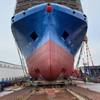Rolls-Royce introduced a pair of new vessels for its popular UT line of vessels, the UT712 and the UT737L. To be built by Soviknes for Island Offshore and delivered in October 2003, the new UT737L, dubbed Island Frontier, takes multi-tasking to dizzying new heights. Under development for almost three years, according to Svein Kleven, Rolls-Royce Marine AS, the design is an evolution of the UT745E, and is particularly notable that it demanded classification society Det Norske Veritas to create a new classification for the type: Ship Shape Well Intervention Unit 1.
While full technical specs on the vessel are still being kept under wraps by the designer for competitive reasons, it is described as a Subsea Support Vessel built for world operations, capable of:
• Subsea installation and module handling
• ROV operations & Well intervention services
• Diving support & Trenching
• Offshore Pipe Laying & Offshore Cable Laying
• Transport (pipes, equipment, cargo)
• Load/Unload alongside pipelaying barge in the
North Sea condition with wave height of 4.6 m and tidal current of 3.5 knots.
To accomplish all of these tasks with an even degree of efficiency and safety, the ship is outfitted with a "Who's Who" list of the latest technology, including a pair of ABB Azipod thrusters; four thrusters, including a pair of swing-up thrusters and a pair of Kamewa tunnel thrusters: a combined package which is designed to provide unprecedented station keeping.
In addition, the ship will feature an Ulstein roll reduction system, a dynamic positioning system to the DNV "Dynpos Autro" notation, a myriad of deck cranes and ROV handling system, a helideck and a moonpool.
UT712
The UT712 was designed to meet the needs of IOS, a joint venture between Norway's Farstad and P&O, a venture, which operates out of Australia. The design is the platform for an evolving series of three generic vessel types, ranging in size from 246 to 285 ft. (75 to 87 m) in length. UT712 is a multifunctional AHTS with a bollard pull of 150 tons, and two are currently under construction at Norway's Simek. The first, which at press time was just undergoing sea trials, was expected for delivery in late March, with the second to follow in July. As the popularity of the AHTS type continues to gain strength, the UT712 is designed to capture market share with a number of design enhancements.
Most notably, the ship's hull is optimized for fuel savings, while the deck design is large for a vessel this size to offer higher cargo carrying capabilities, said Kleven. To the former, the ship's hull features an 27 ft. (8.3 m) depth to the 249 ft. (75.8 m) length overall, allowing for a pronounced vee in the afterbody to give a clean flow of water in the higher speed range, and like many other of the recent designers from Ship Technology - Ulstein in Rolls-Royce. To the latter, the cargo deck area boasts 510 sq. m. of space with four tanks totaling 230 cu. m. It also features a bulbous bow. A high premium has been placed on safety and comfort, with additional efforts going into providing superior station keeping, while minimizing noise and vibration. The UT712 is a link in the Rolls-Royce endeavor to become a one-stop shop, save the final responsibility of actually building the ship. This design series, and others, undoubtedly will play a role in the development of the next generation DPS system, a current R&D project ongoing under the direction of Rolls-Royce's Gunnar Nyland, corporate research. For flexibility of operation, a father and son engine layout has been chosen, based on the Rolls-Royce Bergen C25:33. Specifically, one nine-cylinder engine (2,700 kW) and one six-cylinder unit (1,800 kW) are geared to each shaft, providing a total power of 12,240 hp. For propulsion and maneuverability, the ships are outfitted with tunnel thrusters fore and aft, and a swing up azimuth thruster under the bow. The initial UT712s built by Simek feature a Rauma Brattvaag two drum low pressure hydraulic main winch rated for 550-ton brake holding load and 350-ton pull on the first layer, and a 0-40 m/min hauling speed. A 138-ton secondary winch can handle either synthetic rope or wire.
Subscribe for
Maritime Reporter E-News
Maritime Reporter E-News is the maritime industry's largest circulation and most authoritative ENews Service, delivered to your Email five times per week










